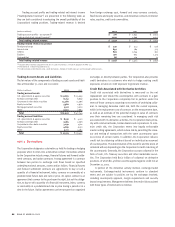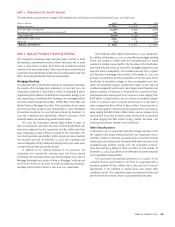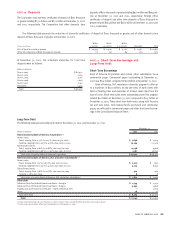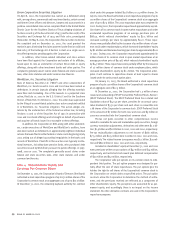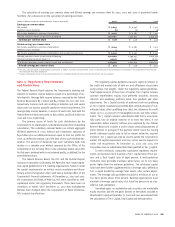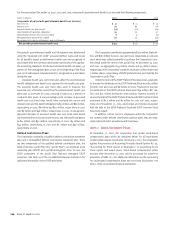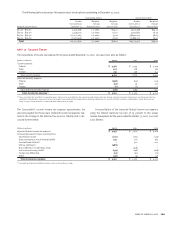Bank of America 2002 Annual Report Download - page 98
Download and view the complete annual report
Please find page 98 of the 2002 Bank of America annual report below. You can navigate through the pages in the report by either clicking on the pages listed below, or by using the keyword search tool below to find specific information within the annual report.
96 BANK OF AMERICA 2002
NOTE 13 Commitments and Contingencies
In the normal course of business, the Corporation enters into a num-
ber of off-balance sheet commitments. These commitments expose
the Corporation to varying degrees of credit and market risk and are
subject to the same credit and market risk limitation reviews as those
recorded on the balance sheet.
Credit Extension Commitments
The Corporation enters into commitments to extend credit such as
loan commitments, standby letters of credit (SBLCs) and commercial
letters of credit to meet the financing needs of its customers. The
unfunded commitments shown in the following table have been
reduced by amounts participated to other financial institutions of
$10.2 billion and $2.2 billion at December 31, 2002 and 2001, respec-
tively. The following table summarizes outstanding unfunded commit-
ments to extend credit at December 31, 2002 and 2001.
(Dollars in millions)
2002 2001
Loan commitments $212,704 $ 221,529
Standby letters of credit and
financial guarantees 30,837 32,416
Commercial letters of credit 3,109 3,581
Legally binding commitments 246,650 257,526
Credit card lines 73,779 73,644
Total commitments $320,429 $ 331,170
Legally binding commitments to extend credit generally have specified
rates and maturities. Certain of these commitments have adverse
change clauses that help to protect the Corporation against deterio-
ration in the borrowers’ ability to pay. Loan commitments include
equity commitments of approximately $2.2 billion and $2.5 billion at
December 31, 2002 and 2001, respectively, which primarily relate to
obligations to fund existing venture capital equity investments.
The Corporation issues SBLCs and financial guarantees to sup-
port the obligations of its customers to beneficiaries. Based on histor-
ical trends, the probability that the Corporation would have to make
payments under a SBLC is not likely. Additionally, in many cases, the
Corporation holds collateral in various forms against these SBLCs. As
part of its risk management activities, the Corporation continuously
monitors the credit-worthiness of the customer as well as SBLC expo-
sure; however, if the customer fails to perform the specified obligation
to the beneficiary, the beneficiary may draw upon the SBLC by pre-
senting documents that are in compliance with the letter of credit
terms. In that event, the Corporation either repays the money bor-
rowed or advanced, makes payment on account of the indebtedness
of the customer or makes payment on account of the default by the
customer in the performance of an obligation, to the beneficiary up to
the full notional amount of the SBLC. The customer
is obligated to
reimburse the Corporation for any such payment. If
the customer fails
to pay, the Corporation would, as applicable, liquidate collateral
and/or set off accounts.
Commercial letters of credit, issued primarily to facilitate customer
trade finance activities, are usually collateralized by the underlying
goods being shipped to the customer and are generally short-term.
Credit card lines are unsecured commitments that are not legally bind-
ing. Management reviews credit card lines at least annually, and upon
evaluation of the customers’ creditworthiness, the Corporation has the
right to terminate or change certain terms of the credit card lines.
The Corporation uses various techniques to manage risk asso-
ciated with these types of instruments including obtaining collateral
and/or adjusting commitment amounts based on the borrower’s
financial condition; therefore, the total commitment amount does not
necessarily represent the actual risk of loss or future cash require-
ments. For each of these types of instruments, the Corporation’s
exposure to credit loss is represented by the contractual amount of
these instruments.
Other Commitments
When-issued securities are commitments to purchase or sell securities
during the time period between the announcement of a securities
offering and the issuance of those securities. Changes in market
price between commitment date and issuance are reflected in trading
account profits. At December 31, 2002, the Corporation had commit-
ments to purchase and sell when-issued securities of $166.1 billion and
$164.5 billion, respectively. At December 31, 2001, the Corporation had
commitments to purchase and sell when-issued securities of $45.0 bil-
lion and $39.6 billion, respectively. The increase was primarily attributa-
ble to higher volumes of mortgage refinancings in the current low
interest rate environment.
At December 31, 2002, the Corporation had forward whole mort-
gage loan purchase commitments of $10.8 billion, all of which were
settled in January 2003. At December 31, 2002, the Corporation had
no forward whole mortgage loan sale commitments.
The Corporation has entered into operating leases for certain of
its premises and equipment. Commitments under these leases
approximate $1.0 billion per year for each of the years 2003 through
2007 and $2.2 billion for all years thereafter.
Other Guarantees
The Corporation sells products that offer book value protection pri-
marily to plan sponsors of ERISA-governed pension plans such as
401(k) plans, 457 plans, etc. The book value protection is provided on
portfolios of intermediate/short-term investment grade fixed income
securities and is intended to cover any shortfall in the event that plan
participants withdraw funds when market value is below book value.
The Corporation retains the option to exit the contract at any time. If
the Corporation exercises its option, the purchaser can require the
Corporation to purchase zero coupon bonds with the proceeds of the
liquidated assets to assure the return of principal. To hedge its expo-
sure, the Corporation imposes significant restrictions and constraints
on the timing of the withdrawals, the manner in which the portfolio is
liquidated and the funds are accessed and the investment parameters
of the underlying portfolio. These constraints, combined with struc-
tural protections, are designed to provide adequate buffers and guard


